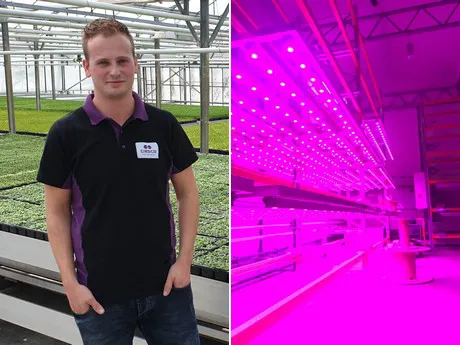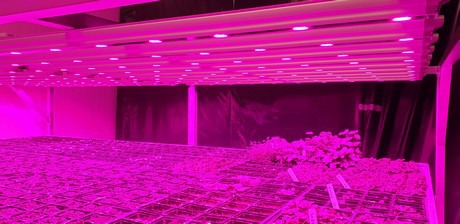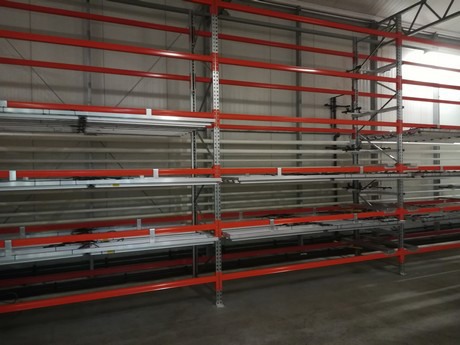On a road in a horticultural area in Honselersdijk, we find the family-run company Cresco. The Prins family has been growing cresses for wholesale and retail for four generations. Cresses are freshly germinated plants, such as garden cress and watercress. We are talking to two generations from the Prins family. They tell about their company and their first experience with the test setup for multi-layer cultivation, which Codema developed and installed together with Signify.

Mitchell Prins
Growing cress is precision growing
Rita Prins tells: “Growing cresses is something totally different to growing tomatoes. With vegetables it is about kilograms, this is about grams. We call that precision growing. We export our cresses via wholesalers to the retail sector and restaurants throughout the whole world. Over time, we have seen eating habits changing. The cresses are used by restaurants as a garnish, but nowadays we also see more and more garden cresses in the supermarkets. In England, our cresses are often eaten as a snack in the pub. Our products have even been in the Hellofresh boxes. So they end up everywhere.”
Continuing to grow vertically
Last January, Cresco began with a test setup for multi-layer cultivation. They sought a partner for this with knowledge and experience in multi-layer cultivation and thus encountered Codema. Mitchell Prins explains why Cresco wants to grow vertically. “Unfortunately, we cannot grow further in width here in Honselersdijk. We are not a hectare grower, but do want to continue to grow. For this reason, we are now researching how attractive it is to start growing vertically. Growing vertically is not new to us. The 2nd generation of Prins already began in 1958 with growing vertically, but that was up to body height. In the future, we want to stack to a height of as much as 12 metres.”

Sales market wants cresses with a long shelf life
The test setup contains two illuminated growing layers and one non-illuminated growing layer. The non-illuminated growing layer (the 0 layer) is used for germinating the seed. Co-owner Mitchell has high expectations for growing in layers: “We have several varieties of cresses in the test setup and it will not be long before the first cresses are produced. With multi-layer cultivation, we expect to be able to grow more efficiently and save on energy. It is not just about efficiency and saving on costs, but we also want to meet the higher demands of the sales market, by supplying cresses which can be kept for longer. We are noticing that the sales market finds this increasingly important. With multi-layer cultivation, we can also shorten the growing period and achieve a higher production. I, therefore, see many advantages and if the test turns out positive, in the future we may switch completely to multi-layer cultivation. Multi-layer cultivation also means a different method of growing for us. We are actually an artisanal growing company. We always manually responded to changing weather influences, but now for the first time, we will combine our knowledge with technology. For us, it is a case of waiting to see how it will work, but the first impressions are positive.”
Fast and equal growth
Tom Könisser is involved in this project as Business Development Manager City Farming at Signify. He explains: “In a multi-layer system, LED light is used in combination with ebb and flow systems or hydroponics technology. The light spectrum can be altered per cultivation layer, which results in a fast and equal growth of the cresses. We use a light recipe, based on uniformity and a particular light intensity. In addition, light, energy and water are used in an efficient way, so the ecological footprint is very small. Furthermore, by growing vertically, efficient use is made of the growing space available. This can be well applied in particular for a low crop, such as cresses.”

Expansion of test setup
Cresco will soon expand the number of growing layers vertically. The test setup will also be expanded with dynamic lighting. The lights can be dimmed and the light colour can be adapted. A specific light recipe influences the taste of the cresses.
“The relation with Codema goes back a number of years”, explains Mitchell. “In 2011, we bought new growing tables from Codema. At that time Codema was still called Wevab. That was a well-known name in the Westland. The experiences with Wevab were good; they always delivered quickly and according to the agreements. When we discovered that Codema was also active in multi-layer cultivation, we approached them with our issue. We are now looking forward to the first results and the further development of the tests.”
For more information: Codema Systems Group
Codema Systems Group
Oosteindsepad 8
2661 EP Bergschenhoek
The Netherlands
+31105212755
[email protected]
www.codemasystemsgroup.com
